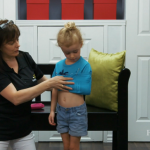

- 4 March 2020
- |
- Andrée Bouchard
With the return of fine weather, we’re exposing ourselves to the sun a little more, and children are particularly sensitive. It is estimated that up to 80% of a person’s total exposure to the sun occurs before the age of 18. For this reason, it’s a good idea to teach children good habits right from the start.
The sun emits two types of ultraviolet (UV) rays that can damage skin and eyes. These are UVA and UVB rays. In general, UVA rays are the least harmful, but they can contribute to skin aging, damage DNA and possibly cause skin cancer. They penetrate deeply and do not cause sunburn (no redness). It is therefore important that your sunscreen blocks both types of rays (broad-spectrum sunscreens).
To calculate the UV index, meteorologists take into account cloud cover, visibility, ozone concentration in the atmosphere, sun elevation, weather conditions and altitude. Weather stations broadcast the UV index daily. Be sure to read them before going out in the sun.
- If the UV index is low (0 to 2), the risk of getting too much sun is low.
- If the UV index is moderate (3-4-5), you should start using sun protection. The amount of ultraviolet radiation to which the skin is exposed always depends on the amount of time spent in the sun. The longer you expose yourself, the greater the risk of burning.
- If the UV index is high (6-7) or very high (8-9-10), you should never expose yourself to the sun without protection, and in the case of a very high index, you should consider avoiding activities in the sun between 11 a.m. and 4 p.m. This is when UV rays are strongest.
Skin cancer is usually caused by exposure to the sun’s ultraviolet rays. The more you’re exposed to the sun in your lifetime, the greater your risk of developing cancer.
To protect young and old alike:
- Dress up. Wear long-sleeved clothing and a wide-brimmed hat (caps don’t protect the back of the neck). Wear sunglasses.
- Stay in the shade. When your shadow is shorter than your waist, it means the sun is very strong (at its zenith). Look for places with lots of shade: a park with tall trees, for example. Always use an umbrella at the beach. Always place a baby in the shade.
- Apply sun lotion. Choose a sunscreen with SPF 30 or higher. The letters SPF stand for Sun Protection Factor. NEVER use baby oil to protect children from the sun. It won’t protect them.
How do I use sunscreen?
- Apply cream about 20 minutes before first exposure. For daycare centers that take children outside, or for children who arrive later than their friends at daycare, parents should be informed that they should apply the first application of sun lotion before leaving the house, to ensure that the child is adequately protected when exposed to the sun.
- Reapply every two hours.
A “waterproof” product means that it will retain 70% of its filtration capacity after 4 20-minute baths. Wateresistant” means that the product will retain 70% of its filtration capacity after 2 40-minute swims. However, it is advisable to reapply the cream after each swim.
Nathalie, director of Forméduc




